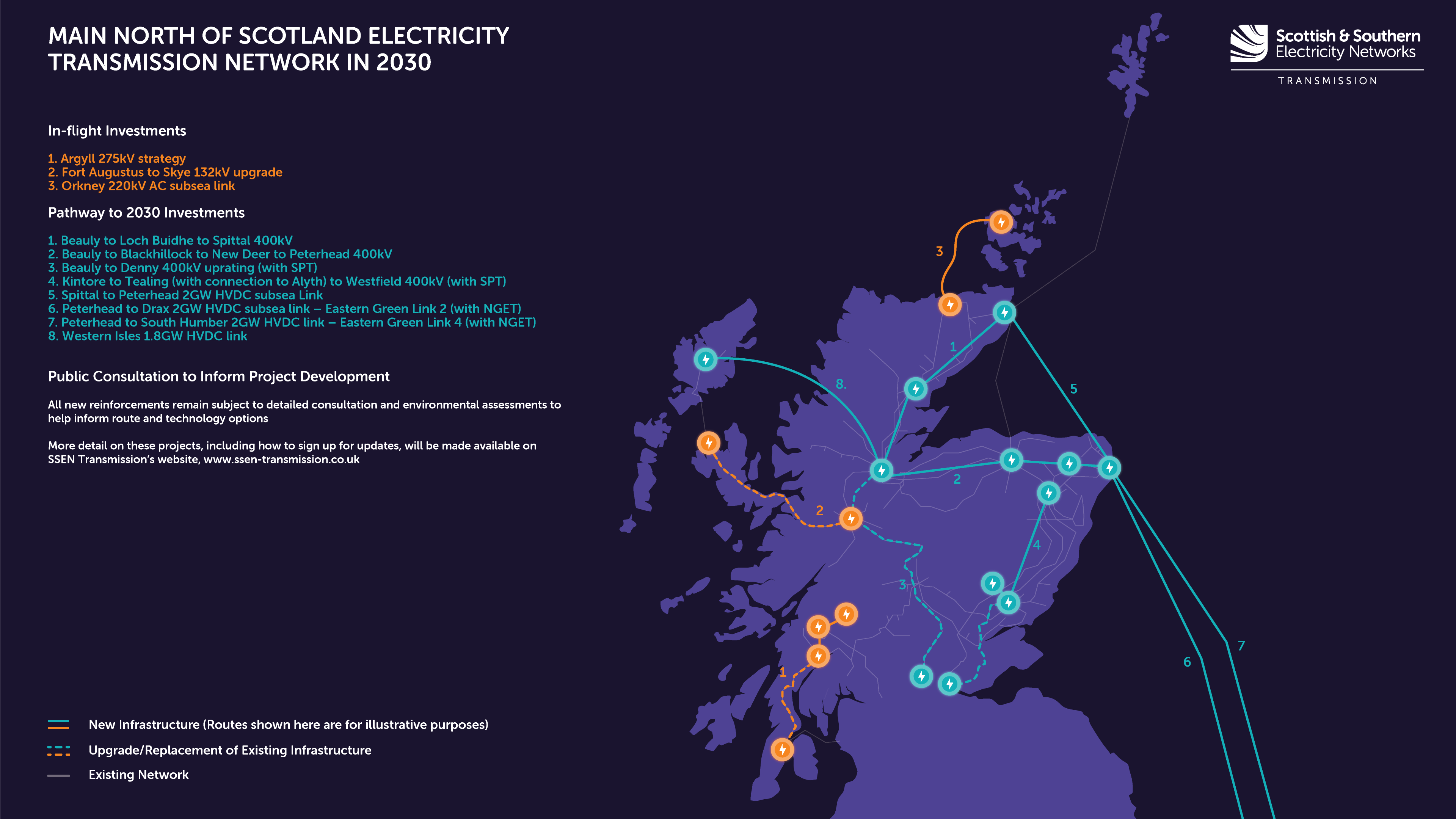Ofgem approves transmission investments required for 2030 Government targets

Energy regulator Ofgem has approved the need for the strategic electricity transmission reinforcements required to deliver the UK Government’s 50GW offshore wind by 2030 target, set out as part of the regulator’s Accelerated Strategic Transmission Investment (ASTI) framework.
The decision confirms that all SSEN Transmission projects identified by the Electricity System Operator (the ESO) as required to meet 2030 offshore wind targets will now be taken forward as part of the ASTI framework.
These are:
- Two 2GW subsea high-voltage direct current (HVDC) links from Peterhead to England, both of which will be taken forward as joint ventures with National Grid Electricity Transmission (NGET);
- A 2GW subsea HVDC link from Spittal in Caithness, connecting to Peterhead;
- A 1.8GW subsea HVDC link from Arnish on the Western Isles to the Beauly area near Inverness;
- 400kV onshore reinforcements, between Beauly, Blackhillock, New Deer and Peterhead; between Beauly, Loch Buidhe and Spittal; and between Kintore, Tealing and Westfield; and
- Uprating the existing Beauly to Denny line to enable 400kV operation on both circuits.
Ofgem has also confirmed that these reinforcements will be exempt from proposals to introduce competitive ownership of onshore electricity networks, which are currently being considered as part of the UK Government’s draft Energy Bill. By confirming existing electricity transmission licensees will remain the delivery body for these reinforcements, Ofgem has provided the much-needed certainty required to support timely and accelerated delivery, including early supply chain engagement.
These investments reinforce the SSE Group’s fully funded Net Zero Acceleration Programme (NZAP), which in Great Britain alone, could see SSE’s investment exceed £24bn this decade, directly alleviating the UK’s energy crisis.
With more material still to be released by Ofgem – particularly the proposed regulatory licence changes to enact the ASTI framework decision which are expected to be consulted on shortly – SSEN will continue to review and assess the detail as it is published to ensure the ASTI framework appropriately balances risk and reward, and is financeable, to enable SSEN Transmission to commit to accelerated delivery for 2030.
Rob McDonald, managing director of SSEN Transmission, said: “Today’s publication of the ASTI Framework is a critical milestone to support our collective net zero and energy security ambitions and we welcome Ofgem’s approval of the need for the investments required to deliver 2030 offshore wind targets.
“Accelerating the development and delivery of the strategic electricity transmission infrastructure required to enable the deployment of homegrown and affordable, low carbon power, is arguably the most important enabler to securing the UK’s future energy security and net zero ambitions. This includes unlocking the first phase of the ScotWind leasing round, supporting UK and Scottish Government targets.
“As we continue to assess the detail of today’s publication and await Ofgem’s proposed regulatory licence changes, we remain committed to work constructively with Ofgem and other stakeholders to establish a regulatory framework that appropriately balances risk and reward, and ultimately accelerates the delivery of electricity transmission infrastructure required to meet our future energy ambitions.”
Ofgem’s decision has been described by Highlands and Islands Enterprise (HIE) as “great news” for the region and the result of “tremendous efforts by stakeholders”.
HIE chief executive, Stuart Black, said: “Clearly this is great news, not just for the Outer Hebrides, but for Scotland and the UK. Stakeholders have made tremendous efforts over many years to make the case for this approval and we’re absolutely delighted to achieve this crucial milestone.
“This will unlock the potential of island wind projects that have been consented for several years. These ‘shovel-ready’ projects will create a great many jobs. In the longer term, ScotWind projects will be able to connect and opportunities for marine energy can be realised. In short, it could be transformational for the economy of the islands and local communities.
“SSE Transmission can now start their procurement process to have the link built and operational by 2030. We very much look forward to working with them and other stakeholders to move the project forward and secure benefits for business and communities across the Outer Hebrides.”
Claire Mack, chief executive at Scottish Renewables, added: “To support our net-zero and energy security ambitions it is vital that industry secures the investment needed to meet our 2030 net-zero targets.
“We welcome today’s publication of the ASTI Framework which is a crucial landmark for the renewable energy industry and support these changes to the current regulatory framework, which will help to accelerate delivery of large projects of which network build is a critical component.”





















